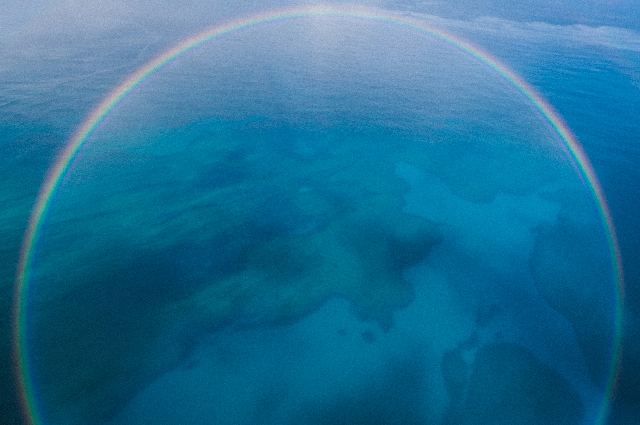
Witnessing a rainbow is always a moment of magic and wonder, but seeing a complete circular rainbow from an airplane elevates this natural phenomenon to an extraordinary experience. Unlike the typical semi-circular rainbows observed from the ground, a full-circle rainbow provides a unique and breathtaking view, revealing the full grandeur of this atmospheric spectacle.
Understanding the Rainbow
Rainbows form when sunlight is refracted, or bent, and then reflected inside water droplets suspended in the air. The process separates light into its constituent colors, creating the familiar spectrum of red, orange, yellow, green, blue, indigo, and violet. Typically, from the ground, we see only a semi-circle or arc of this spectrum because the horizon cuts off the lower part.
The Physics of a Full-Circle Rainbow
The key to seeing a full-circle rainbow lies in elevation. When you’re in an airplane, the horizon is below you, and there is no physical barrier to obstruct the view. The sunlight can interact with water droplets at all angles around the observer, forming a complete circle. This phenomenon occurs because of the consistent 42-degree angle of refraction and reflection within the droplets.
The Best Conditions for Viewing
Observing a full-circle rainbow requires specific conditions:
- Altitude: The higher the airplane, the better the chance to see the entire circle. Typically, altitudes above 30,000 feet provide optimal viewing conditions.
- Sun Position: The sun should be low on the horizon, ideally behind the observer, to cast its rays at the right angle through the atmosphere.
- Moisture in the Air: There needs to be a substantial amount of water droplets in the air, such as after a rain shower or near clouds.
The Experience from an Airplane
Passengers who are fortunate enough to glimpse a full-circle rainbow from an airplane describe it as a surreal and awe-inspiring experience. The sight of an unbroken ring of vibrant colors against the backdrop of the sky and clouds is a rare and beautiful reminder of the wonders of nature. For pilots and frequent flyers, it might be a more familiar sight, but it never loses its charm.
Photographing a Full-Circle Rainbow
Capturing this phenomenon on camera can be challenging due to the reflective nature of airplane windows and the need for a wide-angle lens to encompass the entire circle. Here are some tips for aspiring aerial photographers:
- Use a Polarizing Filter: This can help reduce window reflections and enhance the colors of the rainbow.
- Wide-Angle Lens: To capture the full circle, a wide-angle lens is essential.
- Positioning: Try to position yourself away from direct sunlight to avoid glare.
A Rare and Beautiful Sight
While not an everyday occurrence, the full-circle rainbow is a testament to the beauty and complexity of our atmosphere. It’s a reminder of the delicate interplay between light and water and how changing perspectives—such as viewing from above—can reveal new dimensions of familiar phenomena.
For those lucky enough to see a full-circle rainbow from an airplane, it’s an unforgettable experience that underscores the endless wonders of the natural world. So next time you’re on a flight, especially after a rainstorm, take a moment to look out the window—you might just catch a glimpse of this extraordinary sight.
